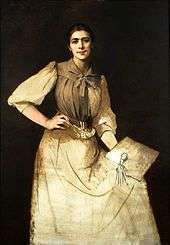Underdrawing
Underdrawing is a preparatory drawing done on a painting ground before paint is applied,[1] for example, an imprimatura or an underpainting. Underdrawing was used extensively by 15th century painters like Jan van Eyck and Rogier van der Weyden. These artists "underdrew" with a brush, using hatching strokes for shading, using water-based black paint, before underpainting and overpainting with oils. Cennino D'Andrea Cennini (14th century most likely) describes a different type of underdrawing, made with graded tones rather than hatching, for egg tempera.

In some cases, underdrawing can be clearly visualized using infrared reflectography because carbon black pigments absorb infrared light, whereas opaque pigments such as lead white are transparent with infrared light. Underdrawing in many works, for example, the Annunciation (van Eyck, Washington) or the Arnolfini Portrait, reveals that artists made alterations, sometimes radical ones, to their compositions.
References
- Infrared reflectography and spectroscopic analysis of paintings
- Preparatory drawing. In: Weyer, Angela; Roig Picazo, Pilar; Pop, Daniel; Cassar, JoAnn; Özköse, Aysun; Jean-Marc, Vallet; Srša, Ivan (Ed.) (2015). Weyer, Angela; Roig Picazo, Pilar; Pop, Daniel; Cassar, JoAnn; Özköse, Aysun; Vallet, Jean-Marc; Srša, Ivan (eds.). EwaGlos. European Illustrated Glossary Of Conservation Terms For Wall Paintings And Architectural Surfaces. English Definitions with translations into Bulgarian, Croatian, French, German, Hungarian, Italian, Polish, Romanian, Spanish and Turkish. Petersberg: Michael Imhof. p. 130. doi:10.5165/hawk-hhg/233.CS1 maint: extra text: authors list (link)